Rededication of Worker Memorial at Weldon Spring honors sacrifice of nuclear and remediation workers
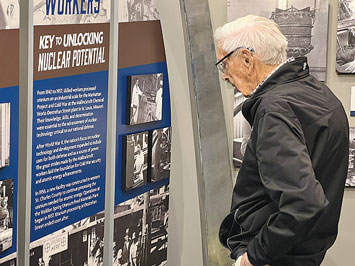
FINAL IN A SERIES
By TIM ROWDEN
Editor-in-Chief
St. Charles County – A rededication of the Worker Memorial at the Weldon Spring Site Interpretive Center honored and paid tribute to the Mallinckrodt workers involved in the nation’s nuclear weapons industry and their surviving family members.
The May 28 program also honored all Missouri Department of Energy (DOE)/Atomic Weapons Employer (AWE) workers, as well as the remediation and construction workers involved in the clean-up and demolition of these sites across Missouri, including Mallinckrodt St. Louis Plant, Mallinckrodt Weldon Spring Plant, United Nuclear Plant, Hematite, Latty Ave., SLAPSS, Tyson Valley Powder Farm and Kansas City Plant/Honeywell.
The ceremony also served as a rededication of the site’s Worker Memorial, a 10 x10 foot replica of the Gateway Arch constructed by Iron Workers Local 396 for the original interpretive center dedicated in 2004 and now housed in the new interpretive center.
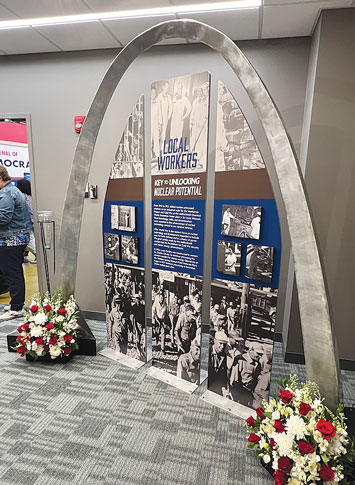
The memorial was constructed at the request of Denise Brock, ombudsman to the Centers for Disease Control and Prevention’s National Institute for Occupational Safety and Health (NIOSH), who has made it her life’s work to honor and assist nuclear and remediation workers and their families for their sacrifice.
Brock extended a special thanks to Local 396, presenting Local 396 President and Business Agent Phil Decker and Business Agent Mike Crowe with a plaque thanking the union for its contribution.
Brock also extended special thanks to other Labor organizations for their help and support honoring nuclear and remediation workers including the Oil Chemical and Atomic Workers, United Auto Workers Local 1887, International Brotherhood of Electrical Workers (IBEW) Local 1, Laborers Local 110, Operating Engineers Local 513, Teamsters Local 688, Plumbers and Pipefitters Local 562 and St. Louis Community College NEA.
“The story of this place is the story of its people,” Brock said. “Here at the highest point in this county we see not just a panorama of skies but the intersection of lives, overlapping contributions to America made by generations. As we can now look down from heights, we know that we are lifted there by the service of those who raised us up. We see your service.”
A museum of the country’s nuclear age and its deep connections to St. Louis, the Weldon Spring Site Interpretive Center sits adjacent to a massive mound of gray rock, under which are buried the byproducts of uranium processing that Mallinckrodt Chemical workers performed at Weldon Spring and other sites during World War II and the Cold War.
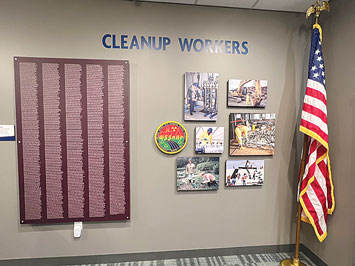
Weldon Spring Ordnance Works served the nation during World War II. Weldon Spring Uranium Feed Materials Plant served the nation during the Cold War.
NATION’S NUCLEAR PROGRAM
Brock gave a brief history of the nation’s nuclear program starting with the Manhattan Project, which produced the first atomic bomb and continuing through site cleanup in the 1990s.
“All of this production came at a steep personal cost to those who carried it out, often under the pressure of successive national emergencies,” Brock said
Many of those workers and their family members became sick with cancer and other ailments later in life. One of them was Brock’s father, who died from lung cancer and leukemia in his early 50s.
“His illness, the horrific suffering, and death were a direct cause from his employment at Mallinckrodt,” Brock said.
“Today, we are here to recognize and honor our Missouri workers who were made ill, or even died, due to their work in this nation’s nuclear weapons industry, including production, plant, construction, dismantling and remediation/clean-up workers.”
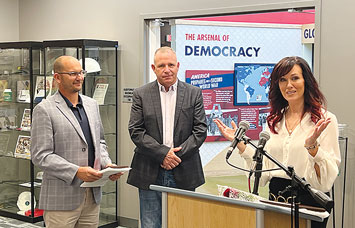
ASSISTANCE FOR WORKERS, FAMILIES
For much of her adult life, Brock has been one of the driving forces behind the Energy Employees Occupational Illness Compensation program, which has paid out billions of dollars to workers and families who gave so much to America’s nuclear age.
“Thousands of these courageous Americans, however, paid a high price for their service, developing disabling or fatal illnesses, as a result of exposure to ionizing radiation, beryllium, chemicals, toxins, all hazards related to nuclear weapons production,” Brock said.
“This involved unique exposures and dangers, including both the potential for catastrophic nuclear accidents, that private insurance carriers have not covered, as well as recurring exposures to some of the most hazardous materials known to humankind.”
Brock said there are over 370 covered sites across the nation and over 700,000 known workers. To date over $23 billion has been paid out, $200 million of that, in Missouri.
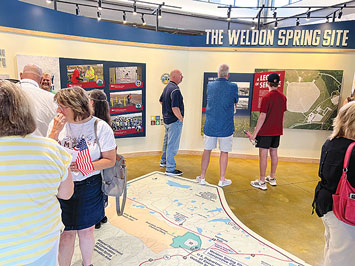
FIND OUT IF YOU QUALIFY
The Building Trades National Medical Screening Program (BTMed) is a database that provides a listing of contractors and subcontractors with a known contractual relationship with various Department of Energy (DOE) facilities that are covered under the Compensation Program Act. It includes subcontractors on the Mallinckrodt Weldon Spring Plant, Mallinckrodt Chemical Company Destrehan Street Facility (downtown St. Louis), the St. Louis Airport Storage Site, as well as sites in other states where local workers may have traveled for jobs.
The U.S. Department of Energy and Department of Labor compiled and updated a list of contractors who worked on those sites to identify which workers may be at risk and added contractors whose employees may have been at risk if their company isn’t currently listed.
The Energy Employees Occupational Illness Compensation Program Act covers any illness that can be caused by, aggravated by or contributed to by toxic exposure.
More information is available at www.btmed.org or by contacting BTMed at 800-866-9663 or Denise Brock at 636-236-0932.



Leave a Reply